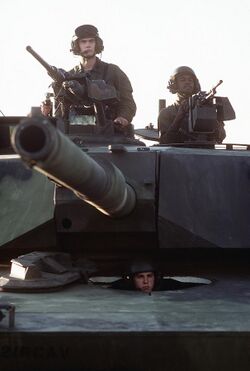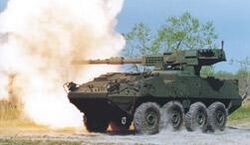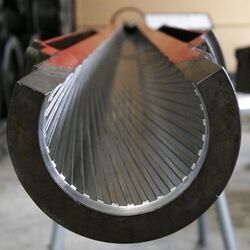Engineering:Royal Ordnance L7
| Royal Ordnance L7 | |
|---|---|
 M68 105mm gun, the American version of the L7, mounted on an M1 Abrams | |
| Type | Rifled Tank gun |
| Place of origin | United Kingdom |
| Production history | |
| Manufacturer | Royal Ordnance Factory |
| Specifications | |
| Mass | 1,282 kg (2,826 lb) |
| Length | 5.89 m (19.3 ft) |
| Barrel length | 52 calibres |
| Calibre | 105 mm (4.13 in) |
| Rate of fire | 10 rounds per minute (maximum) |
The Royal Ordnance L7 is the basic model of the United Kingdom 's most successful tank gun. The L7 is a 105 mm L/52 rifled design by the Royal Ordnance Factories intended for use in armoured fighting vehicles, replacing the earlier 20-pounder (84 mm) tank gun mounted on the Centurion tank.[1] The successful L7 gun has been fitted on many armored vehicles including the British Centurion (starting from the Mk. 5/2 variant), the German Leopard 1 and early variants of the US M1 Abrams (M1 and M1IP).
The L7 is a popular weapon and continued in use even after it was superseded by the L11 series 120 mm rifled tank gun, for some Centurion tanks operating as Artillery Forward Observation and Armoured Vehicle, Royal Engineers (AVRE) vehicles. The L7, and adaptations of it, can be found as standard or retrofitted equipment on a wide variety of tanks developed during the Cold War.
History
Work on what became the L7 began in the early 1950s under Armament Research and Development Establishment at Fort Halstead with the first gun trials in mid-1956.[2] Later that year during the Hungarian Revolution of 1956, a Soviet T-54A medium tank was driven onto the grounds of the British embassy in Budapest by the Hungarians. After a brief examination of this tank's armour and 100 mm gun, British officials decided that the 20 pounder was apparently incapable of defeating it. Hence there was a need to adopt a 105 mm gun.[3]
The L7 was specifically designed to fit into the turret mountings of the 20 pounder. This would enable the Centurions to be upgunned with minimum modifications; hence, the fleet could be upgraded in a shorter time and at a lower cost.
User trials of the weapon began in 1959. The first tank to be equipped with the L7 was a single uparmoured Centurion Mark 7 in 1959 which was to prove the viability of up-armouring and up-gunning the Centurion. From 1959 onwards existing Centurions were given upgrades with the L7 gun and armour and new builds incorporated the L7 at production.[4] The gun was subsequently adopted by the German Leopard 1 (for which the L7A3 variant was developed).
The United States M60 series and earliest versions of the M1 Abrams are armed with the M68 gun, which was designed to fire the same ammunition as the L7.[5] The M68 is also featured on the early Israeli Merkava (also the M68). The Swedish Stridsvagn 103 turretless S-tank (armed with the Bofors L74 with an automatic loader) makes use of an indigenous gun design, which is compatible with rounds made for the L7. In addition, several countries have used the gun to improve the firepower of existing main battle tanks. Derivatives have even been mounted in Warsaw Pact-built T-54 and T-55 tanks in Israel, India, Egypt and Iraq, and Type 79 tanks in China.
Design
The breech uses a horizontally sliding breechblock for loading the fixed cartridge cases. The gun recoils approximately 29 cm (11.5 inch) (in most applications), automatically opening the breech and ejecting the empty cartridge case as the gun returns to battery from full recoil. The barrel of the L7 is fitted with a bore evacuator approximately halfway down its length. The extractor is eccentrically mounted, which is a key recognition feature, though not exclusively for this gun, since its successor, the Rheinmetall 120 mm smoothbore tank gun also features the cylindrical, excentric extractor.
Specification
- Calibre: 105 mm (4.13 in)
- Cartridge: 105×607 mm R, 105×617 mm R
- Barrel length: 52 calibres
- Weight: 1,282 kg (2,826 lb)
- Length: 5.89 m (19 ft 4 in)
- Rate of fire: 10 rounds per minute (maximum)
Ammunition
- APDS
- APERS-T ("Anti-personnel-tracer")
- APFSDS: 1,475 m/s
- Canister
- LAHAT
- Dummy
- HE: 1,174 m/s
- HEAT
- HESH: 737 m/s
- Smoke-White phosphorus incendiary
- Target Practice
- Target Practice Discarding Sabot
Variants

- L7A1
- Standard British production variant.
- L7A3
- Variant for the (West) German Leopard 1 MBT. The upper rear corner of the breech block reduced in size so gun can be depressed without hitting the turret roof.
- M68 (T254E2)
- United States built gun for the M60 Patton. Initially designated as the T254E2, it is a variant of the indigenous U.S. 105mm T254. Unlike the 105mm T254, its tube was interchangeable with that of the British X15E8.[5] It retains the round breech with a vertically-sliding breechblock of the T254 and initially used a concentric bore evacuator, which was later replaced with an eccentric bore evacuator.[6] Also used on the M1 Abrams up until its replacement by the M256 on the M1A1. Used on Israeli tanks up until the Merkava III. Turkish licence built versions by MKEK under the designation of M68T for the 90mm armed M48 took place in the 1980s. The US M68 is also fitted to the M1128 Mobile Gun System (MGS) version of the Stryker 8x8 wheeled combat vehicle.
- M68A1E4
- Variant of the U.S. M68 designed for use on the Stryker MGS, fitted with an automatic loader.
- KM68A1
- Republic of Korea Army's licence-produced variant of the American M68 gun. Used on, M48A5K and K1 tanks.
- Type 79/81/81A/83
- Chinese produced L7. Licence procured from Austria.
- FM K.4 Modelo 1L
- Argentine Army's licence produced by Fabricaciones Militares in Argentina. Used on the TAM medium tank.
- Denel GT-7
- South African built variant for the Olifant Mk1A and Rooikat 105. Incorporates a heavily modified recoil assembly.
Usage
L7 variant
- Centurion: L7A1 cannon on late centurion models and derivatives such as Olifant
- Vickers MBT
- Vijayanta
- Leopard 1: L7A3 cannon
- Type 74: JGSDF main battle tank
- M48 Patton: in some upgraded variants
- M48A2GA2: West German modification
- M48A5E: Spanish modification
- M48A5T2: Turkish modification
- T-54/55: in some upgraded variants
- Type 59-II: Chinese modification of T-54
- Tiran-4Sh: Israeli modification of T-54, both L7 and M68 variants fitted
- Tiran-5Sh: Israeli modification of T-55, both L7 and M68 variants fitted
- Pz-61
- Pz-68
- TAM medium tank
- Maneuver Combat Vehicle: Japanese wheeled tank destroyer
- Type 05: Chinese amphibious light tank
- Type 62G: Chinese light tank
- Type 63A: Chinese amphibious light tank
- Type 79: Chinese MBT
- Type 88: Chinese MBT
M68 variant
- M1 Abrams: M68A1 cannon used early models (M1 and M1IP)
- M47 Patton: in some upgraded variants
- M47M: Iranian modification of US-supplied M47Ms
- Sabalan: Iranian modification
- Tiam: Iranian modification
- M48 Patton: in some upgraded variants
- M48A5: US model
- Magach 3: Israeli modification
- CM11 Brave Tiger: Taiwanese modification
- M48A5K1: South Korean modification
- M48A5T1: Turkish modification
- M60 Patton[7]
- M1128 Mobile Gun System: M68A2 cannon
- K1 Type 88: KM68A1 cannon
- Merkava: Mark I and Mark II models
- T-54/55: in some upgraded variants
- Tiran-4Sh: Israeli modification of T-54, both L7 and M68 variants fitted
- Tiran-5Sh: Israeli modification of T-55, both L7 and M68 variants fitted
- Ramses II: Egyptian modernization
Related Designs with Compatible Ammunition
- EE-T1 Osório
- OF-40
- Stingray light tank
- Strv103
- M47 Patton: in some upgraded variants
- M47E1: Spanish modification armed with a Rheinmetall RH-105/30 gun
- M47E2: Spanish modification armed with a Rheinmetall RH-105/30 gun
Notes
- ↑ Starry, p. 113
- ↑ Dunstan Centurion Tank: 1943-2003 Osprey Publishing p23-24
- ↑ Zaloga 2004, pp 13, 39.
- ↑ Dunstan p24
- ↑ 5.0 5.1 Hunnicutt, R.P. (1984). Patton: A History of the American MBT. Presidio. p. 152.
- ↑ Hunnicutt, R.P. (1984). Patton: A History of the American MBT. Presidio. p. 154.
- ↑ M60 Patton Series - Globalsecurity.org
References
- Zaloga, Steven J. and Hugh Johnson (2004). T-54 and T-55 Main Battle Tanks 1944–2004. Oxford: Osprey. ISBN:1-84176-792-1.
- Starry, Donn A., General. "Mounted Combat In Vietnam." Vietnam Studies. Department of the Army. First printing 1978.
- Hunnicutt, R. P. "Patton: A History of the American Main Battle Tank." 1984; Presidio Press. ISBN:0-89141-230-1.


